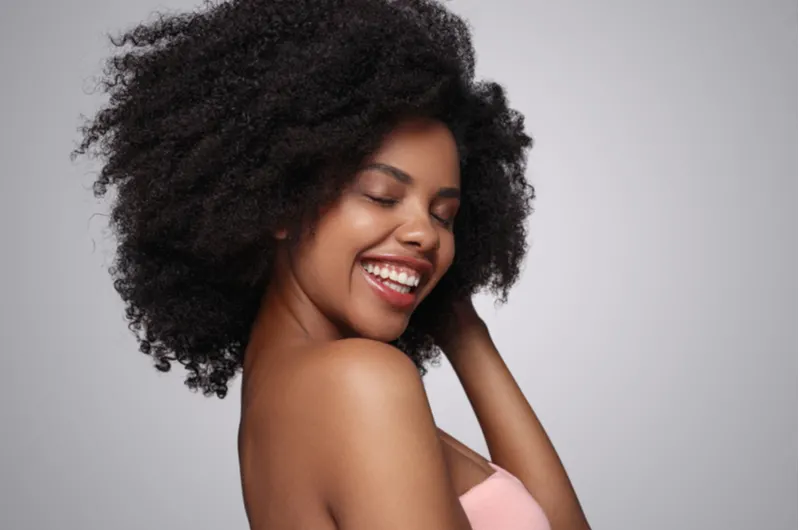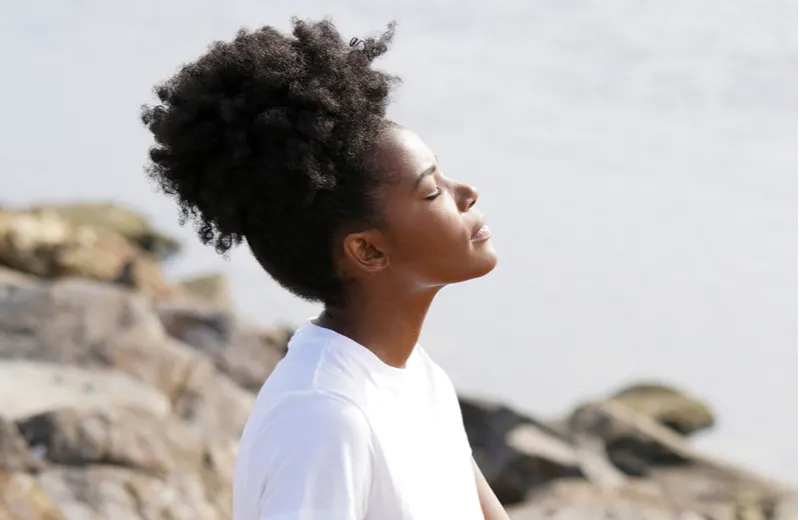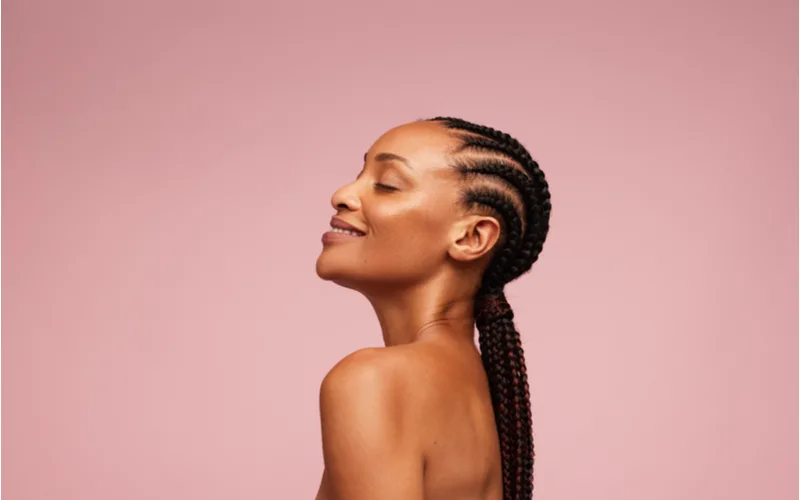Jump to:
Featuring very tight zigzag coils with lots of volume and sporadic definition, the 4B hair type is easily recognized by its unique blend of coil shapes and patterns. Learn all about the 4B coil type, including the best and worst features, proper washing, drying, and styling methods for this hair type.
We’ll also give you some helpful tips to use to keep 4B coils moisturized, defined, and manageable. It’s all here in our quick reference guide! Read to learn more? So are we. Let’s jump in!
What Is the 4B Hair Type?

Mark Nazh/Shutterstock
Type 4B hair is considered kinky-coily and usually has a medium to coarse texture. It features very tight coils that bend in sharp Z-shaped angles (while type 3 curls bend in a softer S-shape).
The coil pattern itself is strong, but definition is lacking or inconsistent with this hair type. That’s likely due to the inherent dryness of the 4B hair type.
Because 4B’s zigzag coils are so highly textured, natural sebum (oil) has a hard time making its way down these voluminous strands. Since oil can’t consistently coat and nourish your hair shaft, chronic dryness becomes an issue.
And as you likely know, that chronic dryness leads to more hair challenges: Frizz, breakage, shrinkage, and fragility among them. But while 4B hair can be a little high-maintenance, there’s a lot to love about this coily hair type.
Coarse 4B hair has built-in damage resistance, tons of flattering volume and body, and responds amazingly well to the right types of products. We’ll get into the details in the next section, but for now, here are the general characteristics of 4B hair.
- Very tight zigzag-shaped coils that are medium to coarse in texture
- Coil definition is poor or inconsistent
- Soaks up moisturizing products like a sponge
- Responds very well to moisture + protein-enriched products
- Prone to considerable shrinkage as it dries
- Prone to chronic dryness and frizz
- Tends to be fragile and may struggle with breakage
Not sure if this accurately describes your hair? You might be one of the other type 4 (coily or kinky) hair types. Here’s the difference between 4A, 4B, and 4C. Which one sounds the most like your mane?
- Type 4A: Fine to coarse, relatively tight O- or S-shaped coils about the size of a coffee stirrer
- Type 4B: Medium to coarse, tight Z-shaped kinky coils; appears like a mass of spongy texture with a few defined coils here and there
- Type 4C: Coarse, extremely tight kinky coils with little definition; appears like a mass of highly textured, voluminous hair and shrinks up to 75% as it dries
If 4B seems to be the best fit, keep reading to learn the ins and outs of your hair type. We’ll cover the pros and cons, the best methods and care techniques for better manageability, and what this hair type needs from you to look and feel its best!
Best Features of 4B Hair
If you have 4B hair, you know there’s a lot to love about it. Your highly textured kinky coils command attention, and the bodacious volume it boasts is impossible to ignore.
This hair type responds amazingly well to the right types of products and is naturally more resistant to damage. Here are some of the best features of 4B hair.
Supremely Kinky
No other hair type has your uniquely sharp-angled, kinky coils. Shaped like tiny zigzags, your strands create their own body and volume to ensure you never struggle with flat, limp, lifeless hair.
The kinky strand shape isn’t easily flattened or stretched out, ensuring better style longevity and enabling you to go longer between washes without your coil shape suffering.
While your persistent kinky coils may get on your nerves a bit when you want a quick style or get tired of layering 5+ products on wash day, you can’t deny that there’s something really lovable about your strand shape and coil pattern!
Big On Volume and Body
The built-in volume and body in the 4B hair type is something to be thankful for. Your mega volume pumps up any hairstyle, adding attractive thickness to your mane and transforming basic styles (ponytails, braids, buns, etc.) into an entire look.
You’ll probably never deal with some of the issues less voluminous hair types regularly struggle with: Flat, greasy roots, limp ponytails, or relying on special products and styling tricks to create the illusion of volume. Definitely one more thing to love about 4B hair!
Responds Well to Products
While some hair types are easily overwhelmed with products formulated to de-frizz, moisturize, define, and hold, your 4B locks have no such problem. Instead, your hair type is known for responding incredibly well to products.
The right products, that is.
The 4B hair type responds best to a range of products in different consistencies and weights. You can’t really over-moisturize or weigh down your mane. Your hair is durable and thick enough to withstand allllll of the heavy products and moisture. In fact, it craves the hydration and control the right products can deliver!
Read Next: What Hair Products Should I Use Quiz
Resistant to Damage
While it’s not immune to damage, the 4B hair type can be resistant to damage when it’s on the coarser side. The more coarse (thick) your individual strands are, the more damage it takes to have an effect.
That’s because your hair strands are “complete,” featuring 3 layers: The cuticle, cortex, and medulla. Finer hair types are missing the innermost layer – the medulla – which makes the hair weaker, more susceptible to damage, and less thick in diameter.
With your coarser strands that contain the outermost cuticle, the cortex, and the innermost medulla, you have the maximum natural damage resistance.
Worst Features of 4B Hair
It’s common for 4B hair to get a bad rap for being high-maintenance. It’s true that there are some unique challenges with this hair type, but it’s nothing you can’t manage with the right care methods and products. Here are some of the most challenging features of 4B hair.
Poor or Inconsistent Definition
While the bigger, O-shaped coils of 4A hair are pretty consistently defined throughout, 4B coils typically present as a mass of textured hair with a few defined kinky coils here and there. This limited coil definition can make wearing your hair down and loose a little more difficult.
You might struggle to coax more definition out of your zigzag coils. You might spend a lot more time applying products on wash day because you’ve found that applying products to individual coil groups is the only way to achieve more definition.
Dryness is a Constant Struggle
The kinky shape of your strands limits your scalp’s natural oils’ ability to travel down and provide moisture and nutrients. It takes a lot longer for slow-moving oil to work its way down your strands, so if you’re not actively adding in moisture daily, you’re sure to struggle with chronic dryness.
Prolonged dryness results in a rougher hair texture, more shrinkage, increased frizz, reduced coil definition, and can lead to length-sabotaging breakage.
Read Next: How to Get Rid of Frizz in Hair
Fragile and Prone to Breakage
Speaking of breakage, this may be an old foe that you’ve been battling for years. It’s not necessarily the fault of the products or methods you’re using. The 4B hair type is naturally fragile due to the sharp bends and kinks in each strand.
Hair is weakest where it bends, so with the 2nd-most coily hair type out there, your mane is definitely one of the most fragile.
It’s not like you’re doomed to endless breakage, though. Gentle manipulation, meeting your hair’s intensive moisture needs, and using protein-fortified products will strengthen your hair and help keep breakage at bay.
Maintenance and Care Tips for 4B Hair
Keeping 4B hair healthy and manageable starts with using the right methods and product types – in the right order. It sounds complicated, but proper 4B hair care is easy. You just need to know the main things your hair is craving and how to deliver it. Keep reading to see your easy 4B hair care tips!
Washing 4B Hair
The 4B hair type does not need to be washed as often as other hair types. You should aim to wash 4B hair about once a week – or less! With your medium to coarse texture and inherent dryness, washing more often than once a week will only lead to problems.
Keys to washing 4B hair:
- Use a sulfate-free moisturizing shampoo. You don’t need harsh, drying sulfates to cleanse your hair. You want to leave as much of your natural sebum intact as possible with each wash to avoid sucking every drop of moisture of your mane.
- Wash once a week or less. You can postpone washing for up to 2-3 weeks if your hair can stand it. The general rule is wash when you see/feel buildup, experience itching or scalp odor, or need to clarify your hair.
- Co-wash with conditioner in between wash days. Since you’ll be washing less often, you’ll need to start co-washing with only conditioner (no shampoo) in between wash days. This will help you regularly add moisture to your strands and keep your coils soft, manageable, and more defined.
Feel like going a week or more between washes is a little too much for your hair? Take our quiz to find out your ideal shampoo schedule: How Often Should I Wash My Hair? Quiz | 5 Questions to Find Your Wash Routine.
Drying 4B Hair
Drying 4B hair requires a little prep for the most definition and shape. If you’ve been struggling with lots of volume but little definition, layering on products in the right order will change your life.
After cleansing and conditioning in the shower, you need to apply the following types of products in this order to your soaking wet hair (and yes, that part’s important).
- Leave-in conditioner
- Mousse or foamy product
- Curl control cream
- Styling gel
- Oil
Applying products in this exact order to sopping wet hair will lock in the water and cut down on frizz. Leave-in conditioner adds a small boost of hydration, mousse provides a basic “scaffold” or structure for your coils to form in, and curl control cream helps set the coils into place with a little hold and more moisture.
Styling gel applied on top provides a more robust structure and more coil definition while supporting and controlling the shape of your coils.
Finally, applying the oil of your choice (we recommend coconut and argan oil) creates a final seal over your layered products and prevents excess moisture from escaping. It also provides some nice shine and frizz control.
Now, let’s talk application methods. You can apply your products all-over or target individual coil groups for maximum coil definition and shape. You don’t need to use the same application method every single time – experiment and find what works best for you.
If that’s all-over product application one week and time-consuming coil targeting the next, that’s okay! Once your products are applied in the right order, your hair is officially prepped and ready to dry.
There are a variety of methods you can use to perfectly air dry your coils to a defined finish, including twisting individual coil groups, rake and shake, pineapple buns, and scrunching. Learn about the curl air drying techniques in our Curly Girl Method guide.
If you choose to diffuse with a hair dryer, don’t skip the vital heat protectant. If you use coconut oil as your final product step, it acts as a natural heat protectant so you can skip this step. If you’re not sealing with oil for whatever reason, buy a spray-on heat protectant to use when you blow dry or heat style.
Styling 4B Hair
If you properly prep your hair with layered products after washing, you’ll be ready to style your 4B hair in a variety of ways. The options are genuinely endless, but we wanted to share some of our favorite go-to style options for the 4B hair type. You’ll find yourself returning to these easy looks again and again!
Go Fro It

Mark Nazh/Shutterstock
Show off your voluminous afro texture by wearing your kinky coils down and loose. Let your hair reach its volume and definition potential with a free-flowing style that celebrates your texture and suits any style from casual to chic. Try different parts – either side, middle, or off-center – to see what best flatters your face shape.
Rock a High Pineapple Pony

Karen Dole/Shutterstock
Pineappling isn’t just a way to air dry your coils overnight without mashing them. It’s also a really simple, cute style to rock any day of the week! Use a comb to slick the front, sides, and back into a sleek ponytail at the crown of your head or higher.
Don’t comb through the midshaft or ends to leave your definition and texture intact. Finish with firm hold gel to keep the ponytail sleek for perfect contrast with your voluminous pineapple pony.
Read Next: How to Pineapple Hair
Experiment With Protective Styles

Braids, twists, knots, dreadlocks, and funky buns are all excellent ways to style and protect your fragile-yet-hardy hair. Experiment with different types of protective styles to encourage growth, prevent and repair damage, and make hair care a million times easier.
Start with short-term protective styles that you can rock for a week or two. If you love it, locs might be a great long-term protective option for you to try!
For more styling options for 4B hair, check out our Natural Hairstyles Guide with 30+ different looks.
Things to Consider
Caring for and managing 4B hair will be a lot easier from here on out. Now that you know the basics (4B hair features, care methods, product application steps, etc.), let’s talk about some of the special considerations 4B hair requires to look and feel its best.
- It’s possible to have more than one hair type. Hair doesn’t always follow the “rules.” It’s possible to have sections of your hair that better fit the 4A (with looser, O-shaped coils) or 4C (with almost no definition and lots of shrinkage) descriptions. If that’s the case, you can apply less or more product to those sections to balance the look. Or let your mane do its thing and embrace the different patterns and textures that make your hair unique!
- Put the brakes on breakage with protein. Adding protein to your strands (which are mostly protein anyway) will fill in any gaps and strengthen them to withstand breakage. Protein-enriched products that contain hydrolyzed (small enough to be absorbed) protein will fortify your hair against breakage and make it less fragile over time. Try or mix up a protein-enriched hair mask once weekly to repair damage and add strength in a single step.
- No such thing as too much moisture. Applying products to soaking wet hair, using moisturizing versions of every product, treating yourself to weekly hair masks, and applying hydration-sealing oils may sound like too much of a good thing. But your chronically dry strands crave moisture and there’s no such thing as too much! Apply moisturizing products freely and often. Your hair will be softer, less frizzy, more defined, and stronger because of it.
The 4B Hair Type: Final Thoughts
There’s no doubt that you’re truly blessed with your voluminous, kinky 4B strands. Damage-resistant, full of luxe volume and body, and easily managed with the right layered products, your type 4B mane is your crowning glory and a major part of your look.
Treat it right and give it what it needs to reap the maximum benefits.That means washing less often, continually adding moisture, layering products in the right order, and fortifying with protein.
Opting for easy styles that put your texture front-and-center or experimenting with damage-defying protective styles is your ticket to easier daily hair care and management. Not convinced you’re truly a 4B?
You might be right – no one knows your mane better than you! Find out your true hair type with our quick and easy quiz next: Take Our Hair Type Quiz | It’s Only 3 Short Questions!
